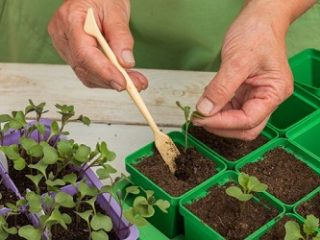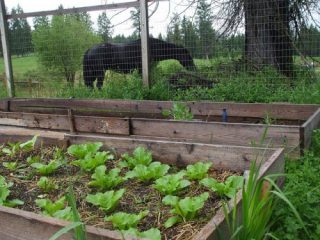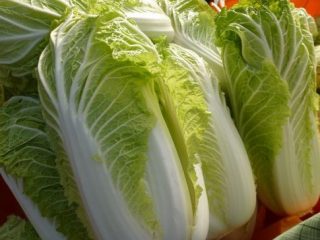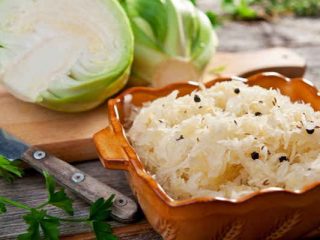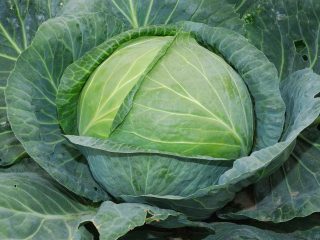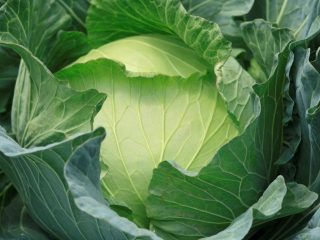Content
Kharkov cabbage is a high-yielding winter hybrid, bred by Ukrainian specialists in the mid-70s. To do this, Amager 611 was crossed with Dauerweiss. The crop is zoned for cultivation in the temperate zone of Ukraine. However, as practice shows, cabbage grows and develops well in all climatic zones, except for the Far Eastern and Siberian regions.
Description
Kharkov cabbage is a late hybrid. Harvesting can begin only 150-160 days after the mass emergence of seedlings. The leaf rosette of cabbage is quite compact and raised. The plate is small and smooth. The leaf shape can be either oval or round. Color – green, with a smoky tint. The surface of the sheet is covered with an intense wax coating. There is a slight waviness along the edges. The head of cabbage of the Kharkov variety is distinguished by its density. Just like the leaf blades, it has a waxy coating. The shape of the head is flat-round. Inside the head of cabbage there is a stalk, the length of which can reach 20 cm.
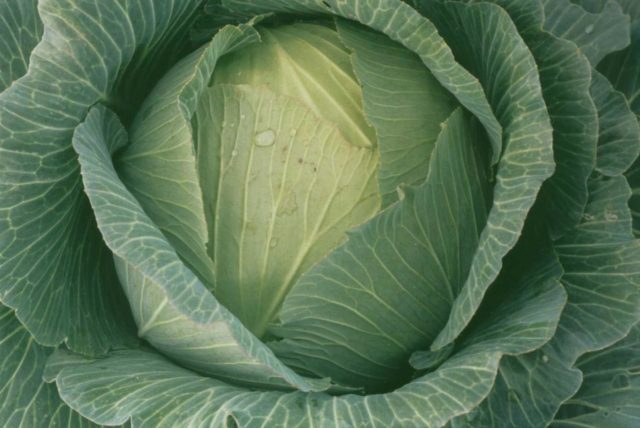
Kharkov cabbage is a variety proven over decades
Advantages and disadvantages
Kharkov cabbage is a fairly old hybrid, but despite this, it remains popular as before. It is grown by both amateur summer residents and professional farmers. And this is not surprising, because no significant deficiencies were found in the Kharkov variety. At the same time, among its advantages are:
- high productivity;
- uniform ripening of the crop;
- drought resistance;
- good transportability;
- high phytoimmunity;
- long shelf life;
- a fairly high level of cold and heat resistance;
- pleasant taste.
Productivity of cabbage variety Kharkovskaya
The Kharkov variety is one of the highest yielding. Typically, its yield varies between 55-85 tons per hectare. The maximum volume is 108 tons per hectare. In recalculation, this is 11 kg per 1 m2. The yield of commercial products exceeds 90%. The average weight of the head is 3.5 kg, but with proper care this figure can reach 4 kg.
Planting and caring for Kharkov cabbage
Kharkov cabbage can be grown both in seedlings and without seedlings. The advantage of the second is that cabbage does not have to get used to new conditions when transferred to a permanent place. In this case, the plant takes root better and grows faster. The ripening period with this growing method is reduced by about 2 weeks. This method is also not without its disadvantages. With the seedless method, seeds need to be sown early, when there is a risk of spring frosts. The latter are a threat to the life of the plant.
To sow seeds of the Kharkov variety in open soil, depressions are made at a distance of 60-70 cm in the selected area. The seeds are laid in the ground no deeper than 2 cm, about 5 grains are placed in each cell. After the plant has two true leaves, small and weak shoots are removed, leaving 2-3. After a while, others are removed, except for one, the strongest plant.
Growing Kharkov cabbage using the seedling method is a more painstaking task. To plant seeds, prepare the soil from peat (75%), humus and sand. If the mixture is not purchased, it is watered with a fungicide solution. Seeds are sown in the second half of April in furrows with soil to a depth of 1 cm. At the same time, a distance between rows of 3 cm is maintained.
For cabbage seedlings to germinate, you need a sunny place and a temperature of + 18-20 °C. In such conditions, the first shoots will appear within 4-5 days. Then the seedlings can be moved to another, cooler area. After 50 days, the cabbage can be transplanted to a permanent place. The optimal planting pattern is 40x50 cm. Each sprout is placed in a hole, filled with water and sprinkled with earth.
Rooted Kharkov cabbage is watered approximately once every 5-6 days. In hot, dry weather, the frequency of irrigation is increased. Water is used purified and heated to room temperature. In the case of young plants of the Kharkov variety, 6 liters of liquid per 1 m2 are consumed. Then this dosage is increased to 12 liters per 1 m2.
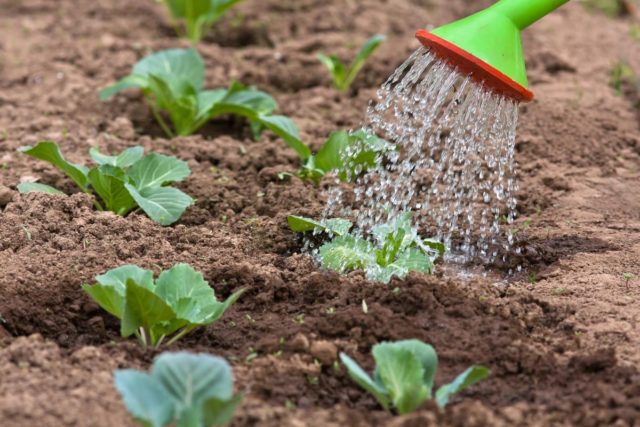
Kharkov cabbage is quite resistant and does not die during drought, but regular watering is necessary for its proper development.
During the entire period of growth and development of Kharkov cabbage, fertilizing is applied to it 4 times after planting:
- In 2 weeks. For this, cow manure is used, 0.5 liters are diluted in a bucket of water.Pour 500 ml of liquid under each cabbage.
- In 4 weeks. The procedure is carried out in the same way as in the previous case.
- After 6 weeks. Dilute 1 tbsp in a bucket of water. l. nitrophoska. Product consumption – 7 liters per 1 m2.
- For week 9. To feed the Kharkov variety, use either cow manure or nitrophoska of your choice.
Removing weeds from the beds and loosening the soil are mandatory procedures. This allows you to saturate the soil with oxygen and reduce the risk of disease development. The procedures are often combined; the frequency depends on watering. Usually they are performed the next day after watering, but at least once every 7-10 days. Hilling cabbage allows you to protect it from pests and prevent heads of cabbage from spreading during the ripening process. Hilling is carried out twice: on the 10th and 45th days after planting in dry and calm weather in the evening (if this is done in the morning or afternoon, the soil will dry out). Hilling is done in such a way that, within a radius of 25 cm from each trunk, a maximum of earth is pulled under the stem. A mound about 30 cm high should form around the cabbage.
Diseases and pests
The Kharkov variety is resistant to most diseases characteristic of cabbage, including bacteriosis, fusarium, rot and necrosis. Since cabbage leaves have a coating on them, they are not attacked by flea beetles or aphids. To prevent all kinds of problems, they are treated with fungicides (Fitoverm) and insecticides (Aliot).
If the cabbage was planted in heavy soil, it may be affected by clubroot. To prevent this from happening, you need to carefully select a place for planting and further care for the plant. Among the pests, slugs are the most dangerous.To combat them, the mixture is scattered on the ground.
Application
The Kharkov variety has a pleasant sweetish taste and high sugar content. The cabbage leaves are tender, juicy and crisp. They have a distinct characteristic odor. Cabbage contains a large amount of ascorbic acid, fiber and various microelements.
The main purpose of this vegetable is consumption raw and boiled, and pickling. Kharkov cabbage makes delicious salads. For raw consumption, experts advise taking the top part of the head. It contains the most delicate leaf plates; it is recommended to cut them finely. For preparing hot dishes, a large shredder is desirable. In this case, it is better to use the rough part of the vegetable.
Cabbage makes excellent pancakes and casseroles, vegetable stews, borscht, cabbage soup, etc. Whole leaves can be used to make cabbage rolls. The rigid petiole of the leaf is not pronounced. Kharkov cabbage reveals itself well when pickled. The high sugar content in its composition is the key to excellent fermentation. At the same time, a large volume of juice prevents the product from spoiling ahead of time.
When fresh, the heads are stored for a long time, about 7 months. At the same time, their taste does not deteriorate, and they do not become less healthy.
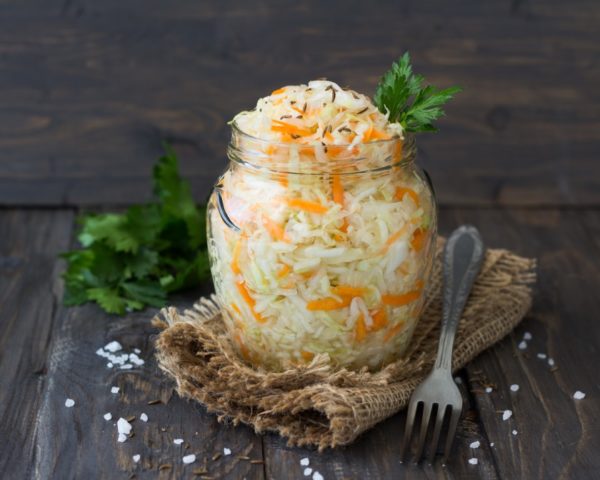
Kharkov cabbage reveals itself well when pickled
Conclusion
Kharkov cabbage is ideal in every sense. It perfectly combines all production and taste qualities. The vegetable has good shelf life and is suitable for preparing any dishes. Getting a good harvest is not difficult; for this you need to follow the basic rules of agricultural technology.
Reviews of Kharkov cabbage
